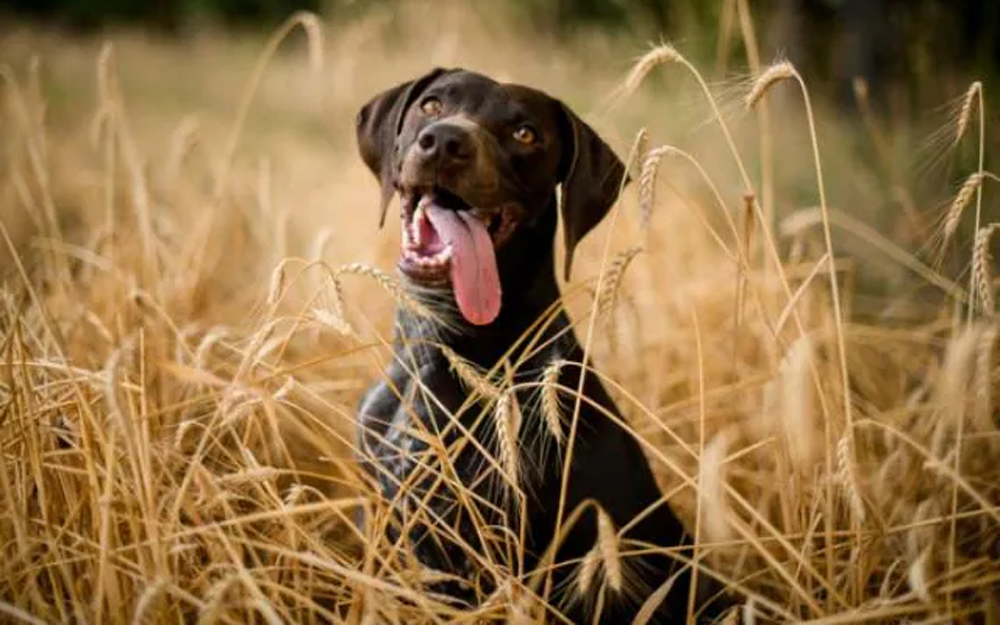
By Janet McAfee
Dog groomers at The Pampered Pet salon have noticed some dogs with foxtails this season. This year’s rainy winter brought a proliferation of the wild grasses. One groomer commented, “The foxtails are horrible. I’ve found them between dogs’ toes, inside the ears, in the genital area, and even in the anal glands. In some cases, pet owners unfamiliar with the spikey dry grass have no idea how dangerous it is.”
Foxtails are common along trails, in fields, in dumps, in marshes, and in meadows. They can invade a dog’s body through various routes and can potentially be lethal if left unchecked. Foxtails can dig deep into your dog’s nostril or ear canal or under the skin in no time, and often so fast you don’t notice them. Because they travel, they can infiltrate and perforate internal organs.
A quick stroke of a foxtail with your fingers can help explain why they are so dangerous for dogs. The barbs, though microscopic, only allow for one direction movement, making it difficult to remove them. The awn only stops traveling inside your dog’s body when it comes to a barrier such as a bone or when it pops through the skin. Since they can’t be absorbed or digested, foxtails can end up lodged in the lungs, heart, brain, liver, and other internal organs. This ability to travel and penetrate makes foxtails extremely dangerous, and they can be fatal.
If your dog encounters foxtails, make sure to carefully comb through its coat. Check around the ears, mouth, nose, and between the toes to remove them before they have chance to invade his body.
The severity of the symptoms depends on how far the foxtail awns have penetrated. Signs your dog had an encounter with foxtails includes:
EXCESSIVE SNEEZING IN CASE OF FOXTAILS INSIDE THE NOSE.
HEAD SHAKING IF FOXTAILS ARE INSIDE THE EAR.
LUMPS ON THE SKIN THAT ARE PAINFUL TO TOUCH.
PAWING AT THE EYES, EYE REDNESS, AND SQUINTING.
DISCHARGE FROM THE POINT OF ENTRY ON THE SKIN.
 Protecting your pet against this nasty weed can help avoid the devastating effects that come with them. Don’t allow your pooch to roam free in fields. Inspect your property, and promptly remove any foxtails growing there. You can spray a solution with white vinegar in water to organically kill the live plants, but you also need to remove the foxtails scattering the ground. Check your dog for foxtails after outdoor sessions and brush them to remove any hidden foxtails in their fur. Dogs that spend a lot of time outdoors and hunting dogs are at higher risk for contact with foxtails. The photo here shows you the plant’s appearance, including the dry awns that are so easily picked up on your dog’s fur.
Protecting your pet against this nasty weed can help avoid the devastating effects that come with them. Don’t allow your pooch to roam free in fields. Inspect your property, and promptly remove any foxtails growing there. You can spray a solution with white vinegar in water to organically kill the live plants, but you also need to remove the foxtails scattering the ground. Check your dog for foxtails after outdoor sessions and brush them to remove any hidden foxtails in their fur. Dogs that spend a lot of time outdoors and hunting dogs are at higher risk for contact with foxtails. The photo here shows you the plant’s appearance, including the dry awns that are so easily picked up on your dog’s fur.
 You can remove foxtails with tweezers if you catch them before they penetrate into the skin. Otherwise, you must seek veterinary help immediately. I recall an incident 7 years ago when a Coachella Valley veterinarian had not encountered foxtails in his practice and failed to initially diagnose a pup shaking her head. That dog was rescued roaming in a field in nearby San Bernardino where these plants are more plentiful. Time is of the essence in getting medical treatment for a dog with foxtails.
You can remove foxtails with tweezers if you catch them before they penetrate into the skin. Otherwise, you must seek veterinary help immediately. I recall an incident 7 years ago when a Coachella Valley veterinarian had not encountered foxtails in his practice and failed to initially diagnose a pup shaking her head. That dog was rescued roaming in a field in nearby San Bernardino where these plants are more plentiful. Time is of the essence in getting medical treatment for a dog with foxtails.
My dog Natalie recently visited a rural area with lots of high grasses. Soon Natalie began shaking her head in serious distress and crying out in pain. No foxtails could be visually seen by inspecting her ears. However, a trip to the emergency vet revealed two foxtails lodged deep inside the ear canal. Untreated, this could have ruptured Natalie’s eardrums and caused chronic ear infections.
Enjoy outdoor walks with Fido but keep an eagle eye out for these dangerous foxtail grasses!











































